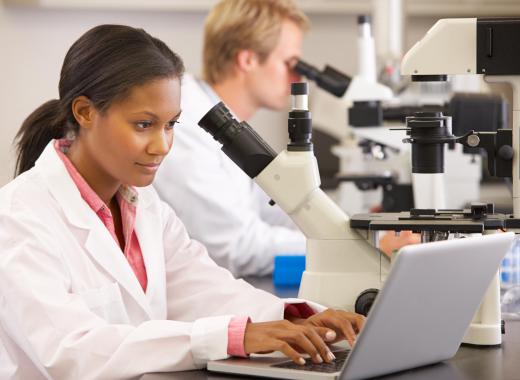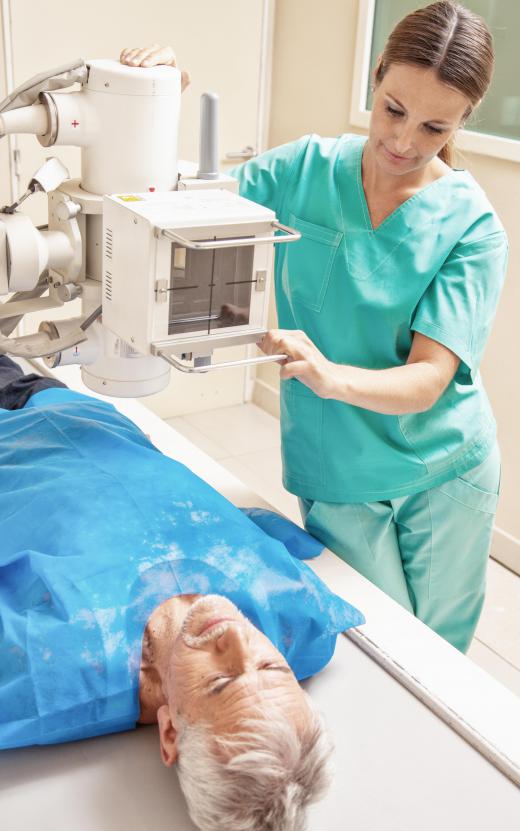What is Tomography?
 Mary McMahon
Mary McMahon
Tomography is a branch of imaging which produces an image called a tomogram which shows a single plane of an object in very specific detail. Many people think of tomography in terms of medical imaging, which is used to create a cross section of the body to reveal underlying medical conditions. Other branches of science also utilize tomography, including biology, geology, oceanography, archeology, and materials science. The technique has been used since the mid twentieth century, although the technology for producing tomograms is constantly improving.
By creating a tomogram, a scientist can look into something without actively cutting it open. In a field like archeology, this ensures that the integrity of specimens is respectfully preserved while they are studied. In medicine, tomography is less invasive than exploratory surgery, and it can provide an excellent idea about what is going on inside the patient for medical providers. Geologists use it to look at cross sections of rock and other material, and the technique even pops up in some high-tech criminal labs so that evidence can be analyzed without being destroyed.

The math behind tomography is quite complex. Essentially, rays are passed through the object being imaged, and the rays, or the tomograph machine are moved during the imaging process to blur out other planes and pull one cross section into sharp detail. Usually the specimen is kept still, and keeping still is an important direction in medical imaging to ensure crisp images. Unfortunately for patients, the medical devices used to create tomographic images can be very noisy and cramped, making the direction to hold still very uncomfortable.

A number of different rays are used in tomography, including X-rays, gamma rays, ultrasound, magnetic resonance, and others. Once images of the object in question have been acquired, they are run through a computer program which cleans up the images and creates a clear cross-section. Some computer reconstruction programs can also create a three dimensional image of the object which can be manipulated to get more information about its internal workings.

As with other imaging techniques which bombard objects with energy, tomography can be dangerous. People who regularly perform tomographic imaging usually shield themselves by standing behind a barrier or wearing special gear which is designed to resist harmful radiation. For patients, a certain amount of lifetime exposure is somewhat inevitable, but it does become a concern when a patient is subjected to repeated diagnostic imaging in an attempt to get to the bottom of a medical problem.
AS FEATURED ON:
AS FEATURED ON:














Discussion Comments
I didn't know that archaeologists could use tomography to protect their artifacts. That is an awesome tool to have when you are working with items that are thousands of years old.
I've often wondered how they kept from destroying pieces that they unearthed. I've seen video of archaeologists brushing dirt away with a special brush and painstakingly digging around something to remove it, but that is pretty cool that they can look inside it without putting the whole project in jeopardy.
I guess archaeologists probably use some sort of x-ray on a casket before cracking it open. I would think that would help them know how to best proceed.
I've heard that dental x-rays can be dangerous. That is why patients always have to wear lead aprons while having them done.
They say that the radiation could cause thyroid cancer eventually. I have heard that a bitewing x-ray does not really give you much more radiation than the sun does in a day, but I guess it can build up over the years inside you.
I really don't see why they need to see inside your teeth. If you don't have any pain or problems, why would you need an x-ray?
My dentist only does x-rays on me once a year, but my friend's dentist does them every six-months. I think I would consider switching dentists if I were her.
@wavy58 – I'm a little surprised that your doctor gives you yearly MRIs. My mother has a kidney condition, and she gets an ultrasound, which seems much less dramatic. Also, she only has to have one every three years.
The technician rubs what looks like a computer mouse across my mother's abdomen to get a good look at her kidneys. Then, she has to flip over and have it rubbed across her back. The detail that this type of tomography can show is pretty amazing.
The one thing that she doesn't like about the ultrasound is that it hurts. Her kidneys are pretty tender, and the technician has to mash down fairly hard to get a good image.
I get an MRI every year so that my nephrologist can monitor my kidney disease. I have a condition that causes multiple cysts to form on my kidneys, and they grow larger over time.
It is pretty neat that they can see my kidneys without ever having to send a scope inside my body or cut me open. I am a little concerned about all the radiation, though, since I have one every year.
Going inside the MRI machine is like being in a coffin. I close my eyes before they send me into it, because I would be terribly claustrophobic if I saw how closed in I was. My elbow once bumped the sides of the tunnel, and that freaked me out a little to know that the walls were that close all around me.
The article is good. can you please tell me about Tomography using Ultrasounds. its application and scope?
Post your comments